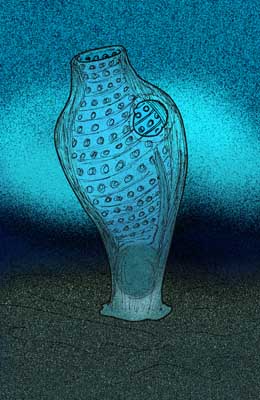Burykhia
| Burykhia | ||||||||
|---|---|---|---|---|---|---|---|---|

Reconstruction of Burykhia as an organism related to tunicata |
||||||||
| Temporal occurrence | ||||||||
| Ediacarium | ||||||||
| 555 million years | ||||||||
| Locations | ||||||||
| Systematics | ||||||||
|
||||||||
| Scientific name | ||||||||
| Burykhia | ||||||||
| Fedonkin , Vickers-Rich, Swalla, Trusler & Hall, 2012 | ||||||||
| species | ||||||||
|
||||||||
Burykhia is an extinct animal genus of the Ediacarium , which in the fossil record is likely to bethe oldest sea squirt taxon ( tunicates , Ascidiacea).
etymology
The genus Burykhia was named in honor of Tatyana Andreevna and Timofei Antonovich Burych - residents of the village of Sjusma who had actively helped with field work. The taxon hunti honors Nathan Hunt, the patron of geological-palaeontological studies in the Neoproterozoic of Russia.
Occurrence and first description
The type locality of the holotype is in the Verkhovka Formation on the right bank of the Syusma , 5 kilometers from its confluence with the White Sea ( Arkhangelsk Oblast ). The fossil was discovered in 1995 and first scientifically described in 2012 by Fedonkin , Vickers-Rich , Swalla, Trusler, and Hall.
description
Burykhia hunti is the internal imprint of a sack-shaped organism with a maximum length of 135 and a width of up to 97 millimeters, which is girded by perforated bands. The individual, parallel bands are separated from one another by burr-like, 0.5 to 1.0 millimeter wide elevations. The oval openings, depressions or "windows" attached at regular intervals to one another are analogous to the lung sacs of modern tunicata. Between the individual depressions there are flat elevations which, when the entire fossil is viewed, form "longitudinal" ridges perpendicular to the bands. As a special feature of Burykhia, one of these spines has a zigzag-like ridge on which the perforated bands meet one another offset by half a band due to sliding reflection . This structure is associated with an endostyle.
Burykhia was evidently not a colonizing organism but a single living organism.
Taxonomy
Together with the somewhat younger taxon Ausia , Burykhia forms the family of Ausiidae within the class of Ascidiacea . An affinity for the subordination Phlebobranchia is suggested by the vessels running parallel to the ligaments.
Even if the classification of Burykhia among the tunicates is more than likely, other affinities were also considered, such as for sponges ( Hexactinellidae ), archaeocyathids or bryozoa . A possible relationship with soft corals - sea feathers (Pennatulacea) belonging to the octocorals - was also discussed.
Socialization
Burykhia occurs at the type locality together with pteridinium and rangea .
Individual evidence
- ↑ a b c Fedonkin, MA, Vickers-Rich, P., Swalla, BJ, Trusler, P. and Hall, M .: A new metazoan from the Vendian of the White Sea, Russia, with possible affinities to the ascidians . In: Paleontological Journal . 46, No. 1, 2012, p. 1-11 , doi : 10.1134 / S0031030112010042 .
- ^ Hahn, G. and Pflug, HD: Polyp-like organisms from the Young Cambrian (Nama group of Namibia) . In: Geol. Paleontol. tape 19 , 1985, pp. 1-13 .